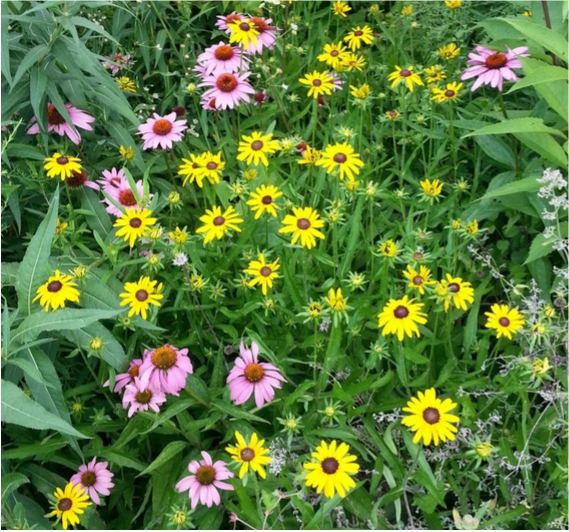|
Plants that occur naturally in an area are called native plants. Water from our homes travels through pipes to a water treatment plant or a septic system for disinfection and removal of solids. The cleaned water is then released back into the environment, for example, to a river. Native plants act as nature's water treatment plants. Rain water becomes polluted by air pollutants, and by picking up chemicals and other contaminants from every surface it comes into contact with. For example, traces of fertilizers and weed-killers that we use in our yards are picked up by rain water. Many native plants have deep root systems that extend much farther into the soil than the height of the plant. When rain is allowed to stay on the site where it falls, it is taken up, filtered, chemically altered, and stored by native plants. |
Planting native plants is an easy, low-cost way that we can reduce water pollution.
|
More Benefits of Native Plants
|
Find Plants for Your Garden
Sun or shade, wet or dry soil, there is a plant that is native to the conditions in your yard. Use these resources to help you discover them:
Natural Resources Conservation Service compiled lists of Illinois native plants for different stormwater applications. A more general list is available from Chicago Wilderness of plants native to the Chicago region, organized by light requirements. The Morton Arboretum's Tree and Plant Finder allows you to search by numerous features, including whether a plant is native to Chicago, Illinois or North America. Information on 80,000 plant species in the southern Lake Michigan region is available through the vHerbarium. The Xerces Society provides a list of native plants that are highly attractive to pollinators in Pollinator Plants: Great Lakes Region and another for the Midwest Region. The Wild Ones promotes landscaping with native plants and provides a variety of resources. The US EPA's "Greenacres" page provides information on several topics about landscaping with native plants in the Midwest, and state native plant lists. |
Native Trees and Shrubs
The Watershed Forestry Resource Guide explains how trees help to prevent stormwater runoff, and includes lots of links to additional resources.
The National Tree Benefit Calculator estimates the amount of stormwater that a given tree will intercept in a year based on species and size, as well as an estimation of total economic value of that tree. The Morton Arboretum's Tree and Plant Finder may be used to search for native trees appropriate for the conditions on your site. |
|
LWVLMR acknowledges and is grateful for support for this Rooting for Clean Water project from an Illinois Coastal Management Grant. The grant provides partial funding under the Coastal Zone Management Act, by NOAA's Office of Ocean and Coastal Resource Management in conjunction with the Illinois Coastal Management Program, Illinois Department of Natural Resources.
The statements, findings, conclusions, and recommendations are ours and do not necessarily reflect the views of NOAA's Office of Ocean and Coastal Resource Management or the U.S. Department of Commerce. |
LWVLMR also is grateful for technical assistance and in-kind donations for this project from:
- Charlotte Adelman, Co-Author of The Midwestern Native Garden-Native Alternatives to Nonnative Flowers and Plants, Prairie Directory of North America, and the forthcoming Midwestern Native Shrubs & Trees-Gardening Alternatives to Nonnative Species
- Monica Buckley, Owner, Red Stem Native Landscapes, Inc., a Chicago firm that designs, installs, maintains, and cares for native plant gardens
- The Pizzo Group
- Prairie Moon Nursery



